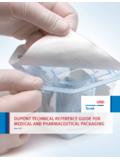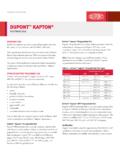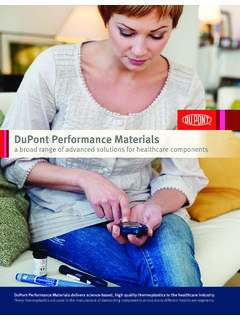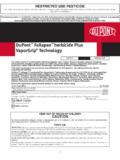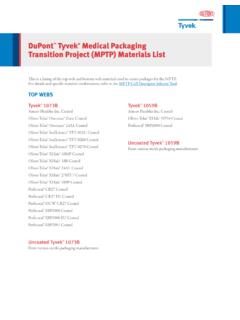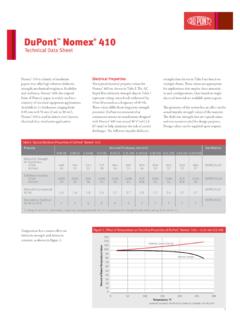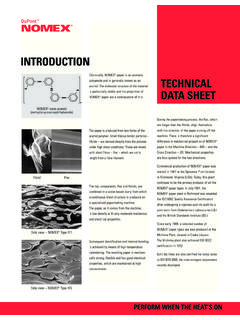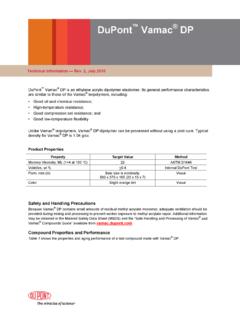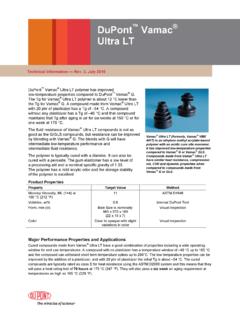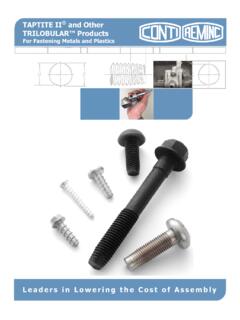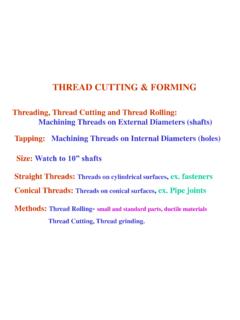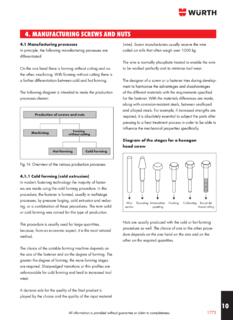Transcription of 9 Assembly Techniques Category I Screws, Press-Fit, Snap-fit
1 IntroductionPlastic parts can be joined using a variety of Assembly tech-niques ; some of them allowing disassembly ( Category I),others creating a permanent joint (welding, Category II). Mechanical FastenersThe self-tapping screw cuts or forms a thread as it isinserted, eliminating the need for moulding an internalthread or a separate tapping operation. Plastic ThreadsWhen required, external- and internal threads can beautomatically moulded onto the part, eliminating theneed for mechanical thread - forming operations. Press-FittingsThis technique provides joints with high strength at lowcost. In general, suggested interferences are largerbetween thermoplastic parts than metal parts because of the lower elastic modulus.
2 The increased interferencecan produce production savings due to greater latitudein production tolerances. The effects of thermal cyclingand stress relaxation on the strength of the joint mustbe carefully evaluated. Snap-FitsSnap fitting provides a simple, inexpensive and rapidmeans of assembling plastic parts. Basically, a mouldedundercut on one part engages a mating lip on the method of Assembly is uniquely suited to thermo-plastic materials due to flexibility, high elongation andability to be moulded into complex shapes. Spin Welding (see Chapter 10)Spin welding produces welds that are strong, permanentand stress free. In spin welding, the part surfaces to bewelded are pressed together as they are rotated relativeto each other at high speed.
3 Frictional heat is generatedat the joint between the surfaces. After a film of meltedthermoplastic has been formed, rotation is stopped andthe weld is allowed to seal under pressure. Ultrasonic Welding (see Chapter 10)Similar plastic parts can be fused together through thegeneration of frictional heat in ultrasonic welding. Thisrapid sealing technique, usually less than two seconds,can be fully automated for high speed and high produc-tion. Close attention to details such as part and jointdesign, welding variables, fixturing and moisture con-tent is required. Vibration Welding (see Chapter 10)Vibration welding is based on the principle of frictionwelding.
4 In vibration welding, the heat necessary to meltthe plastic is generated by pressing one part against theother and vibrating it through a small relative displace-ment at the joint. Heat generated by the friction melts theplastic at the interface. Vibration is stopped and the partis automatically aligned; pressure is maintained until theplastic solidifies to bond the parts together. The bondobtained approaches the strength of the parent material. Hot Plate Welding (see Chapter 10)Hot plate welding is a technique used for joining thermo-plastic parts. Non symmetric parts with fragile internalcomponents are suitable for this technique.
5 Laser Welding (see Chapter 10)Two plastic parts, of which one must be made out of a transparent material, are welded together using laserlight for melting both materials at the joint. Cold or Hot Heading/Riveting (see Chapter 10)This useful, low-cost Assembly technique forms strong,permanent mechanical joints. Heading is accomplishedby compression loading the end of a rivet while holdingand containing the body. Adhesion Bonding (see Chapter 10)This technique is used to join plastics or plastics and dissimilar materials. It is useful when joining large orcomplicated shapes. Details on methods and techniqueswill be found in the individual product for DisassemblyIn order to reduce the impact on the environment as muchas possible, the design and the material should be selectedto allow the most efficient use of the part over its servicelife.
6 This may included re-use of the part or some of itscomponents. For this reason, it is really important to Design for Disassembly . In chapter 10 information andrecommendations related to this subject are given, whichshould help designers in creating more optimal FastenersSelf-Tapping ScrewsSelf-Tapping screws provide an economical means forjoining plastics. Dissimilar materials can be joined togetherand the joint can be disassembled and major types of self-tapping screws are thread formingand thread cutting. As the name implies, thread formingscrews deform the material into which they are driven, forming threads in the plastic part.
7 thread cutting screwson the other hand, physically remove material, like amachine tap, to form the thread . To determine what kindof self-tapping screw is best for a job, the designer mustknow which plastic will be used, and its modulus of the modulus is below 1500 MPa, thread forming screwsare suitable, as the material can be deformed withoutentailing high hoop Assembly Techniques Category I Screws, Press-Fit, Snap-fitWhen the flexural modulus of a plastic is between 1500and 3000 MPa, the proper type of self-tapping screwbecomes somewhat indeterminate. Generally speaking,the stress generated by a thread forming screw will betoo great for this group of resins, and thread cuttingscrews should be employed.
8 However, plastics such asZYTEL nylon resin and DELRIN acetal resin work wellwith thread forming cutting screws are still preferred unless repeateddisassembly is necessary. thread forming screws ABand B, shown in Fig. arefast driving, spaced- thread screws. The BPscrew is muchthe same as the Bscrew except that it has a 45 includedangle and unthreaded cone points. The cone point is usefulin aligning mating holes during Assembly . The Utype,blunt point, is a multiple- thread drive screw intended forpermanent fastening. The Utype screw is not recom-mended where removal of the screw is anticipated. Special thread forming screws, like the Trilobular, whichare designed to reduce radial pressure, frequently can beused for this range of modulus of elasticity, see Fig.
9 Screws with non-circular cross sections use to haveslightly increased driving- and stripping unique thread form, the Hi-Lo fastener, has adouble lead thread where one thread is high and the otherlow. A sharp 30 included thread angle allows for a deepercut into the material and reduces the hoop stress that wouldbe generated by a conventional 60 thread angle design feature is that the Hi-Lo screw has a smaller minor diameter than a conventional increases the material in contact with the high flatthread, increasing the axial shear area. All of this con-tributes to a greater resistance to pull out and a strongerfastener. This style of screw can be either thread form-ing or thread cutting with the thread cutting variety usedon even higher modulus third group of resins with elastic moduli in the 3000and 7000 MPa range gain their strength from reinforcingglass fibres.
10 Typical of resins in this Category are the13 % glass-reinforced ZYTEL nylon resin materials andMINLON mineral-reinforced materials. These resins arebest fastened with thread cutting screws. In these morerigid materials, thread cutting screws will provide highthread engagement, high clamp loads, and will not inducehigh residual stress that could cause product failure last group of plastics, those with flexural moduliabove 7000 MPa are relatively brittle and at times tendto granulate between the threads causing fastener pullout at lower than predicted force values. Resins in thishigher modulus Category are the 33 % and 43 % glass-reinforced ZYTEL nylon resins, RYNITE PET-reinforcedpolyester terephthalate resin, and CRASTIN PBT-rein-forced polybutyl terephthalate resin and DuPont highperformance polyamide resin ZYTEL configuration designed byContinental screw Co.
